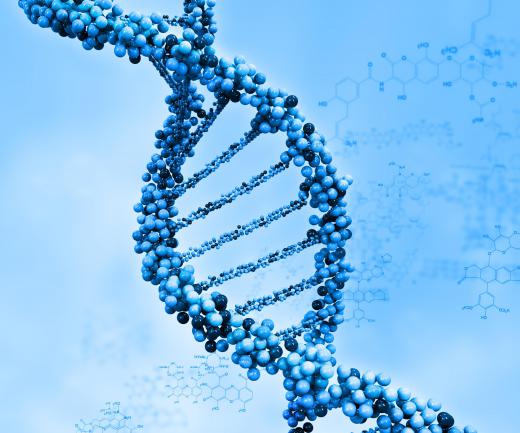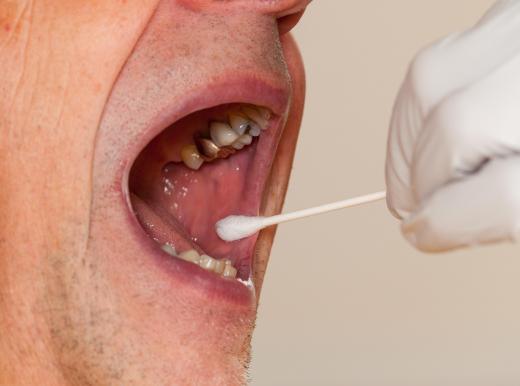What is a DNA Fingerprint?
 Mary Elizabeth
Mary Elizabeth
A DNA fingerprint is the same thing as DNA testing, DNA typing, DNA profiling, DNA analysis and genetic fingerprinting. It refers to identification of an individual based on his or her DNA profile. One of the most important uses of this technique is in forensic science, and this is widely known due to its prominent use in police procedurals.
In 1985, Dr. Alec Jeffreys, and English geneticist, became the first to describe DNA fingerprinting when he worked out a technique to examine variations in DNA repeat sequences that allowed identity tests to be performed on human subjects. The repeated sections are called variable number of tandem repeats or VNTRs and the technique that Dr. Jeffreys developed was called RFLP because it used restriction fragment length polymorphism. The first court cases in which Dr. Jeffreys' methodology was used in were English case involving immigration and a double homicide, which it helped solve.

In DNA sample processing in forensic labs in the US, smaller versions of VNTRs, called STR markers are used. The DNA is copied using polymerase chain reaction (PCR) and the sample is then genotyped. Combining individual STR genotypes yields the DNA profile or fingerprint. It can then be compared to other samples that are known reference samples from people such as the victim and identified suspects.

With the advent of DNA testing, the types of biological evidence that were forensically useful expanded. In addition, DNA made evidence such as discarded tissues, cotton swabs, toothpicks, cigarette butts, stamps, and empty bottles, cans, or glasses have more to offer than the possibility of a fingerprint. All these items, with their sweat, skin, mucus, blood, semen, ear wax, and/or saliva offer the possibility of DNA and the ability to identify a person’s presence and possibly activity at a crime scene.

DNA fingerprinting also has application in paternity testing and ecological research. In paternity testing, the genotype of child is compared to mother and alleged father(s). No match leads to an exclusion. If there is a match, or inclusion, then the DNA fingerprint is compared to appropriate ethnic population database, and the probability of relationship is calculated and reported. In ecological research, DNA fingerprinting has helped in identification of extra pair offspring (EPO) the name given to chicks that have been sired by a male partner other than their social partner. This has led to the realization that the EPO are ahead of their half siblings because of actions by their mothers.
AS FEATURED ON:
AS FEATURED ON:
















Discussion Comments
DNA fingerprinting provided information that helped my best friend find her father. She had often suspected that the man her mother had married was not him, and she turned out to be right.
She found out about her mother's old boyfriend through family members, and after tracking him down, she was amazed at how much she resembled him. She knew he probably would never agree to submitting a DNA sample for testing, so she just pretended she was there to interview him about his job for a school project.
During the interview, she offered him a drink. She took the cup with her once it was over, and she had the DNA tested. When she got the results back, she told him who she really was, and it caused quite a bit of turmoil in the family, but at least the truth came to light.
@alisha – How bittersweet it must have been for those prisoners who were freed decades after their incarceration because of DNA fingerprinting! They must have felt such conflicting emotions.
On one hand, much of their lives had already been wasted behind bars. They could never get those years back, and if their loved ones had died during their time in prison, then that would add to their sorrow.
On the other hand, their reputations were finally cleared. The public knew for a fact that they were innocent, so their chances of getting a job and making friends greatly increased. Also, they were suddenly free to enjoy life again.
In the days before the public caught on, offering a suspect a cigarette or a drink in the interrogation room was a great way to sneak their DNA out of them. Now, suspects have become wary of touching anything that could leave this behind if they are actually guilty.
I suppose that if there was good enough reason to believe a person was guilty, then a judge could make the person submit their DNA for testing. If not, then cops would be forced to rely on gathering items that the person had touched or used.
DNA fingerprinting does not mean gathering a literal fingerprint. A DNA fingerprint can be the material left behind by everything from skin cells to saliva.
The term “fingerprint” is used loosely here. It's kind of like how you could say an interior designer really left her fingerprint on a room. You wouldn't be referring to the literal print of her finger. You would mean that the work could be identified as hers by the elements composing it.
I think it's a cool way to refer to a person's identifying factor. Whether it's in the form of lip cells on a glass or mucus on a tissue, it is still a DNA fingerprint.
@ddljohn-- No, same egg twins don't have the same fingerprint. No two individual on earth carry the same fingerprint, which is what makes DNA fingerprint testing so important and dependable.
DNA is a fairly trustworthy method to identify individuals. Paternity tests (the proper ones, not the fake ones sold online) show 99.999% likelihood of paternity if the individual is the father. That's as good as it gets. What that means is that the individual is 99.999% more likely than all other males in his race to be that child's father.
About DNA fingerprinting, it works a little differently. Fingerprint testing doesn't give a percentage. The computer either matches the fingerprint with another or it doesn't. The only shortcomings of DNA fingerprint testing for investigation purposes is that a partial fingerprint may not be enough to make the comparison. The other shortcoming is that this whole system depends on DNA fingerprint banks. Without fingerprints in the bank, a match is not likely.
Thankfully, in the US, DNA banks are some of the best in the world. Very few countries have extensive enough DNA banks to use these testing mechanisms to identify individuals.
@alisha-- You speak very highly of DNA fingerprint testing. I don't underestimate the value of forensic DNA in criminal investigations but is it really that dependable?
On TV, I often hear that in DNA paternity testing, the results are 99% positive. So even if it is small, doesn't that leave room for a different result? I feel that like all things, DNA testing, fingerprint or otherwise is open to false results too.
And what about same egg twins? Don't they have the same fingerprint? How are we supposed to overcome that issue in DNA testing?
DNA fingerprint and DNA in general has completely revolutionized the way crimes are solved in my view. Before DNA testing was available, there was no way of being hundred percent sure about who had committed a crime. If enough evidence was there for a prosecution, it was made. But sometimes the wrong person was implicated, innocents were punished while criminals roamed free.
DNA fingerprint has completely changed that. Now all it requires to know who held a gun, or who was at which location is a DNA fingerprint test and comparison. Not only has this made law enforcement's job easier but I think it has made persecutions just too.
In fact, some criminal cases which had gone unresolved or which were reopened after the use of DNA fingerprint, have been resolved thanks to it. And several persecuted individuals were proven to be innocent and released!
Post your comments